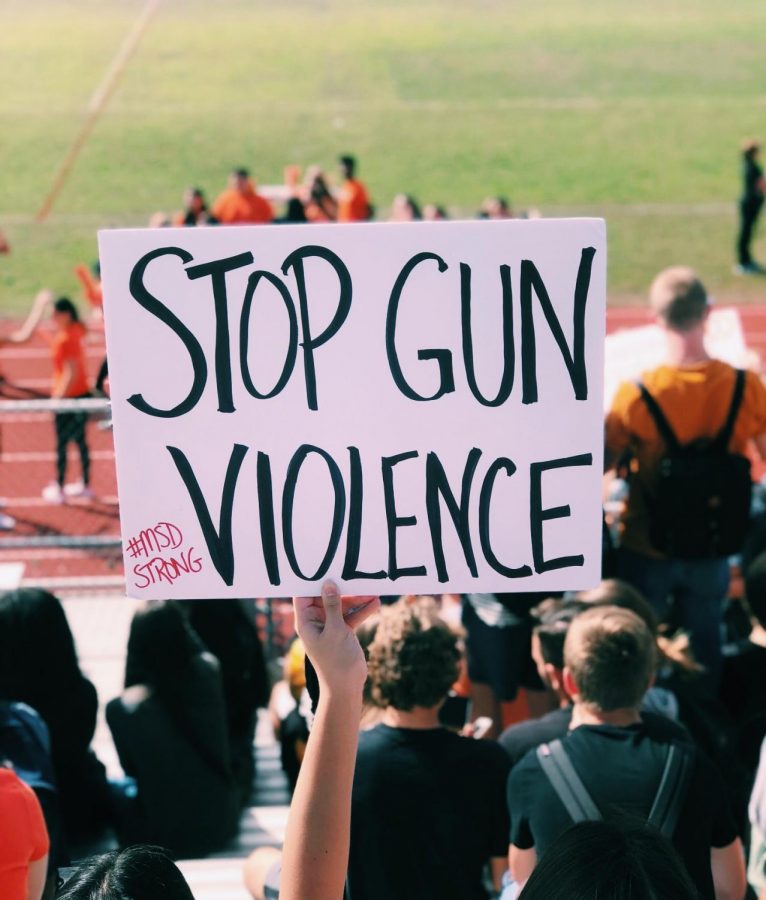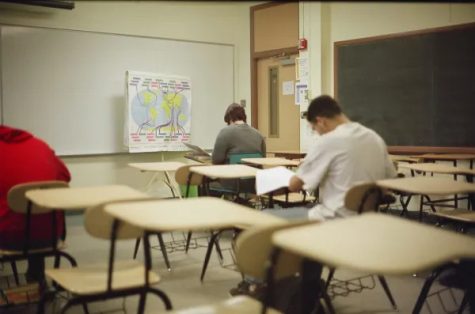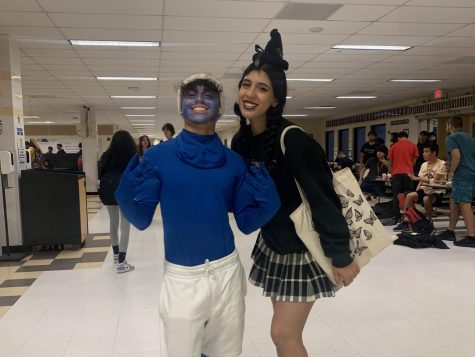Students walk out to support Marjory Stoneman Douglas
Students gather in bleachers carrying protest posters to the Feb. 21 walkout.
During the Feb. 21 walkout, students mirrored the past actions of teens, commonly referred to as rebels without a cause, during the 1950’s. While the teens of the 50’s were focused solely on rebelling against adults, a growing movement of teens today are concerned with future gun control legislation and safety measures within schools.
The aim of the walkout was to show support for the students and staff affected by the Marjory Stoneman Douglas school shooting, as well as to support the enactment of gun control laws. At 10 a.m., students were allowed to walk out and protest without punishment or to stay in class and go about their normal day. While principal Jimmy Arrojo didn’t officially endorse the walkout, Arrojo and the rest of the administration stood on the football field among the student protesters.
The walkout was originally organized by students over social media, but after Arrojo met with student leaders on Feb. 20, the event transformed into a more structured school function that took place on the football field. During the protest, students who started chants and held posters with friends on the field were promptly ushered to the bleachers by staff and administration.
After everyone was seated, the Student Government Association carried orange banners on to the football field that featured the dates, locations and lives lost of previous American school shootings. Following the banner presentation, junior Isabel Wood gave an emotionally charged speech discussing the recent tragedy. Wood displayed her sadness and frustration by crying at one point while she discussed the closeness she felt to the shooting.
“When I was writing [my speech], I remained more logical than emotional, so that we could remember the victims of the shooting and advocate for gun safety reforms. [Giving the speech] was nerve-racking, but I wasn’t so overwhelmed because I have experience in debate and public speaking. I was mostly scared that the audience wouldn’t be receptive to it, but thankfully the audience was respectful,” Wood said.
The walkout concluded with Arrojo making the final statement. After the event, some students resumed school and attended lunch or class.
Many, including those who walked out and those who stayed in, expressed disappointment with how heavily involved the administration was. Sophomore Jane Dubelier is one of many students who was let down by the organization of the protest. Since the event didn’t entail students leaving school property, Dubelier considered the walkout as ineffective compared to the protests at other schools.
“In some aspects, I thought the walkout brought awareness, but compared to other schools, I don’t think we got the attention we wanted. Administration misinterpreted what we wanted to do,” Dubelier said.
Arrojo said his primary goal was to create an impactful and organized protest that didn’t incorporate violence or disorderly conduct. Arrojo, select students and staff collaborated to ensure that the demonstration wasn’t about the students at Western protesting, but that the protest was solely focused on the students and staff of Marjory Stoneman Douglas.
“I wasn’t trying to stop anyone from protesting, but I wanted to make sure that it was a safe, schoolwide demonstration. Once I knew what was going to happen, I contacted student leaders from various clubs to see if we could do something that was impactful. Overall, I was concerned with everyone being safe. That was my primary concern,” Arrojo said.
Others deemed the protest as a memorial since the event focused on paying tribute to those who died rather protesting gun violence. While Arrojo did mention the growing concern of gun violence, the central point of his statement was to encourage Western students to show support for Stoneman Douglas. On the other hand, Wood’s statement surrounded gun violence and sympathy for the individuals at Stoneman Douglas.
“A lot of people felt like they were denied voicing their opinion and having an actual protest. I understand that Arrojo didn’t want the school sponsored event to offend everyone. I felt like it was a beautiful display of solidarity, but it was more of a memorial and not a protest,” senior Joshua Bullock said.
Along with verbal protesting, many utilized their clothing and artistic expression to convey their stance. The color orange was worn to represent resilience against gun violence and black clothing was used to mourn the 17 lives lost. The student designed posters ranged from simply featuring the slogans “Never Again” and “Enough is Enough” to elaborate art pieces, yet all of them conveyed a strong political or personal message that expressed their empathy for those affected or their dissatisfaction with current gun control policies.
While most of the school walked out, there were some students and teachers that decided to stay inside. Freshman Robert Scott remained in the building during the walkout to make up a test he missed. Although Scott’s primary reason for not attending was his plans to take a test, Scott said he wouldn’t have attended anyway.
“One of the reasons I didn’t go is that a lot of people didn’t know what they were there for and just wanted an hour out of class. Also, there was no media there, really, so the protest didn’t catch on as much as the Tallahassee rally,” Scott said.
While not officially on campus, Local 10 news and Channel 6 news aired a report and helicopter videos of the rally on the evening news. The news crews were not allowed on school campus, but they filmed from the other side of the school fence.
“A lot of people were saying that [the students] should be following the rules, but in history, change has never happened by following the rules. We have to challenge institutions and structures to make changes. I want to remind everyone that we need to be united and that protesting is about love, not division,” Bullock said.








